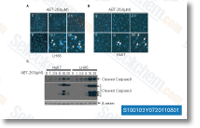Additionally to these alcohols, production of acetate and lactate was observed. Formation of lowered, non acidic, fermentation items may be a constructed in mechanism for bacteria to mitigate extra acetate or lactate formation, which could decrease the pH on the growth medium to a point that could not be effective to your organism. Conceivably, metabolic pathways can be engineered to divert carbon away from two carbon merchandise this kind of as ethanol and acetate and in direction of decreased 3 and 4 carbon solutions this kind of as glycerol or butanediol. The findings presented right here appear to suggest C. saccharolyticus has many routes offered by which this strategy may very well be implemented. On top of that our discovering that C.
saccharolyticus generates considerable amounts of ethylene glycol in the course of development on D arabinose, apparently from glycolaldehye through the L fucose pathway adds this diminished fermentation solution that may be of interest in industrial biotechnology as being a products read review of lignocellulosic biomass. Resources and tactics Reagents Elements of your growth medium have been obtained from Sigma and implemented without the need of further purification. Carbon 13 labeled glucose was obtained from Cambridge Isotope Laboratories. Bacterial strain and growth problems C. saccharolyticus DSM 8903 was obtained from the Deutsche Sammlung von Mikroorganismen und Zellkulturen. C. saccharolyticus was grown inside the anaerobic BA medium. The BA medium composition continues to be described previously. BA medium consists of The vitamin resolution and cysteine made use of previously in BA medium were omitted, and as an alternative the medium was supplemented with 2 gL yeast extract as well as the ideal monosaccharide substrate selleckchem Raf Inhibitors at a concentra tion of ten gL.
Media had been produced anaerobic by flushing with N2CO2. To compare the growth along with the metabolite amounts across the different monosaccharides tested, C. saccharolyticus was grown on D glucose, D mannose, D xylose, L arabinose, D arabinose, L fucose, and D fucose  in batch cultures. The growth was additional tested in constant culture with L arabinose, D arabinose, D mannose and D xylose as substrate. Batch cultivation experiments have been performed by using a culture volume of twenty ml in an airtight flask at 65 C. Constant cultivation was performed 60 C in an INFORS HT Multifors bench leading bioreactor at a continuous working volume of 0. five L with stirring at a hundred rpm. The pH was managed at 7. 0 by automatic addition of NaOH to the vessel. Fresh media was additional at a rate of 0. 12 mlmin. The computer software Iris V5 was employed to control the bioreactor and analyze and archive the data. The BA medium from the vessel of your bioreactor was inoculated with 1% of seed culture within the exponential growth phase.
in batch cultures. The growth was additional tested in constant culture with L arabinose, D arabinose, D mannose and D xylose as substrate. Batch cultivation experiments have been performed by using a culture volume of twenty ml in an airtight flask at 65 C. Constant cultivation was performed 60 C in an INFORS HT Multifors bench leading bioreactor at a continuous working volume of 0. five L with stirring at a hundred rpm. The pH was managed at 7. 0 by automatic addition of NaOH to the vessel. Fresh media was additional at a rate of 0. 12 mlmin. The computer software Iris V5 was employed to control the bioreactor and analyze and archive the data. The BA medium from the vessel of your bioreactor was inoculated with 1% of seed culture within the exponential growth phase.
Sodium Channel Signal
Sodium channels are highly selective for the transport of ions across cell membranes.
